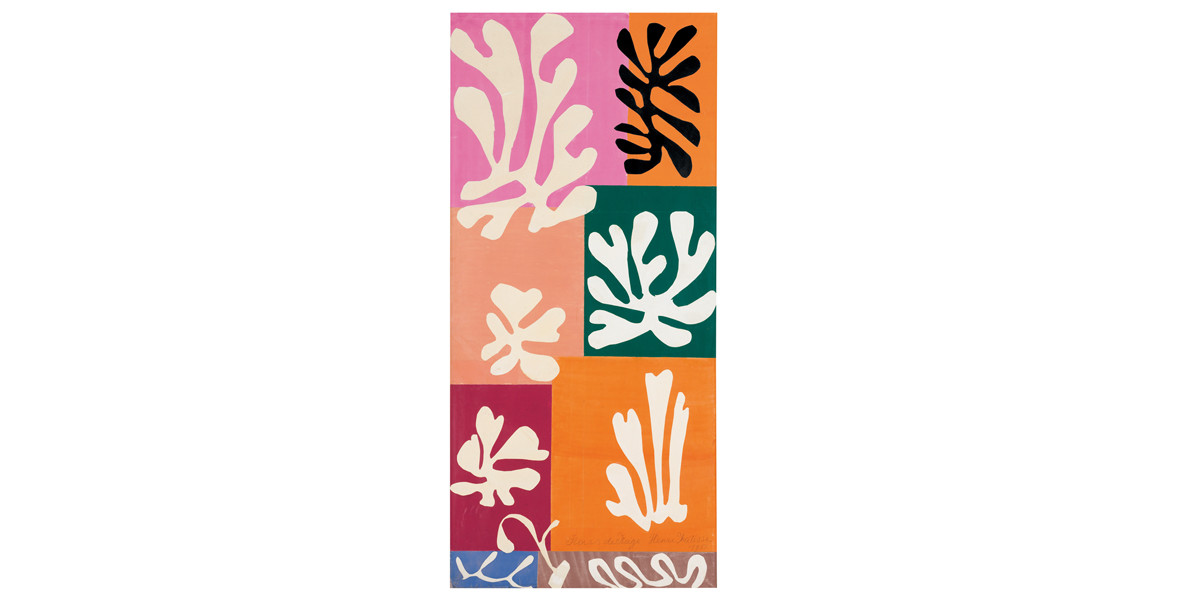Cutting it fine
Cutting it fine
By Mali Morris RA
Published 3 March 2014
As Tate Modern mounts a major show of Matisse’s cut-outs, painter Mali Morris RA pays tribute to the artist’s directness, inventiveness and exuberance
-
From the Spring 2014 issue of RA Magazine, issued quarterly to Friends of the RA.
There is a 47-second film clip on YouTube of a seated Matisse cutting into a sheet of painted paper. The scissors look very big, a curvy shape appears, and he begins to twist the colour yellow around in space. Then he shuffles some cut forms together and lifts the result up to his face, for scrutiny. A few years later, near the end of his life, often bedridden or working from a wheelchair, he produced his huge cut-out works, some around 10 metres wide. The components were by then being pinned up on the walls of his room and moved around to his direction by assistants. The compositions had become environments, the distance from his bed giving the long view.
The lively near-symmetry of Four-Petalled Flower (1945-46) probably had an influence on my early work. Its current whereabouts is unknown but I sometimes catch sight of it in books and think ‘I did that’ – but of course I didn’t. It was reproduced in 1978 in John Elderfield’s The Cut-Outs of Henri Matisse and I was shocked by its audacity. That same year I made a painting called Spats, which had blue petal shapes reaching out from the centre to the edges, but months passed before I recognised the connection.
-

Henri Matisse, Snow Flowers, 1951.
-
Thirty-five years and many paintings later I am now, in works such as Glide (2013, pictured top), building chequered grounds with colour blocks. This is the first stage of a painting process, and its architecture is another echo of what I love in some of Matisse’s cut-outs.
The last time I saw the tall vertical Snow Flowers I remember not wanting to leave it, feeling mesmerised. It was because of the flux of subtlety and drama; the slow drift of rose into gold in the grid supporting the shapes; a heavy green and a crimson sitting in there too; and the wild white upstanding shapes, all of a family but completely individual, a smaller black one challenging the others, linked tonally with the dark olive.
This chromatic orchestration in and out of pictorial space is inseparable from a literal, collaged layering, as fronds overlap or touch edges, some crisp, some soft. The intricacies of the flat white opaque forms are seen against rectangles of broad directional washes, and this opens up yet another distance. It is a dance through time as well as space, as the eye keeps returning to these never-static relationships. The strangest feeling, as I remember it, was to locate the white shapes locked safely into the colour grid, but to see them also as free and ready to enter our space, our world. Every time I’ve seen it – once in New York, once in Paris, and twice in London at the Royal Academy – I have felt addressed directly, the immediacy of this sensation putting me, and keeping me, firmly and vividly in the present moment, even as I notice the handwriting along the lowest cut edge: ‘Fleurs de Neige Henri Matisse 1951’.
We read Matisse now with hindsight, and it takes effort to imagine him at the early stage of any of his discoveries, trying something out, working through it, beginning to understand. It will be a revelation to see 120 of the cut-outs gathered together for a major show at Tate Modern this spring. We are more used to seeing them in the company of the earlier paintings, or singly, lucky to have the great L’Escargot (1953) in London. But in this show we will be able to concentrate on them as a group, cross-refer them with each other, sift through their variety, recognise their authority.
The conundrum of these masterpieces is that they are decorative without being designs, pictorial without being paintings, heart-stopping in their directness, their economy, their inventiveness. These contradictions might make for strenuous viewing as well as for exhilaration and pleasure, as the compression of a lifetime’s work becomes apparent. It is this I am always moved by, being drawn in to what Matisse was teaching himself, as he took those risks and turnings, taking the rest of us with him.
Henri Matisse: The Cut-Outs is at Tate Modern, 17 April – 7 September 2014.
Odelay & Wishpool – Mali Morris and Stephen Lewis: Paintings, Sculpture and Works on Paper is at Kapil Jariwala, 2 May – 28 June 2014.
Matisse: The Chapel at Vence by Marie-Thérèse Pulvenis de Séligny, £60, RA Publications. Mali Morris RA was elected a Royal Academician in 2010
-
-
Enjoyed this article?
Become a Friend to receive RA Magazine
As well as free entry to all of our exhibitions, Friends of the RA enjoy one of Britain’s most respected art magazines, delivered directly to your door.
Why not join the club?
-





